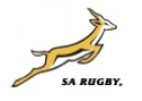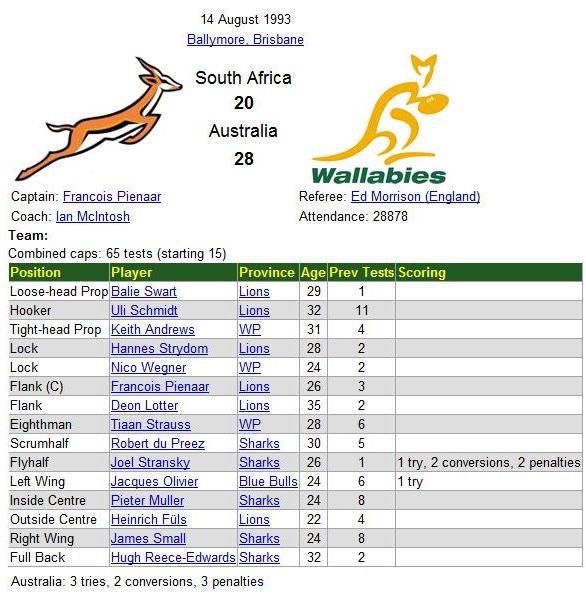
 Second test – 14 August 1993 – Ballymore, Brisbane
Second test – 14 August 1993 – Ballymore, Brisbane
This Test was probably the Test that made the biggest impression on me of all the Test matches I’ve seen in my life mostly because of the way Australia played and won the Test. The tactics they employed and the extraordinary precision of execution impressed me immensely.
South Africa re-entered the International Rugby community in 1992 with a Test against the All Blacks on 15 August 1992 and one against Australia on 22 August 1992 at home. The Springboks lost both Tests (24-27 against New Zealand and 3-26 against Australia). Most people can probably not even remember the Test against Australia but the Test against New Zealand is remembered for the two Danie Gerber –past his best – tries. Under the Captaincy of Naas Botha and with John Williams as coach, South Africa went on an end of year tour to the UK and France in October and November 1992. They won the first one against France but were heavily criticized for the 10-man style of playing they employed in that match. South Africa succumbed to pressure and tried to play running rugby in the second Test against the French and lost badly. They also lost their next (and last math of the tour) against England (16-33).
The 1993 season started with Ian Macintosh being appointed as coach and the Springboks played two Tests at home against a touring French side in June 1993 drawing the first one (20 all) and a losing the second one (17-18).
It was a pretty strong Springbok touring side and the Australian media praised the team afterwards as one of the best sides that ever toured their country. A number of Springbok legends like André Joubert, Joost van der Westhuizen and Henry Honiball started their careers. Robert du Preez and Joost was in a fierce competition for the No 9 Test spot, with Du Preez eventually playing in all three Tests.
The Springbok team that played in the second Test can be seen here:
South Africa lost only one of their tour games, namely against Queensland and won the first Test which had the Australian media pulling the Wallabies to shreds. This produced an pretty intense atmosphere for the second Test in Brisbane but the Wallabies under Phil Kearns came to the party that day and produced one of the best displays of rugby I’ve witnessed in my life.
The Wallaby tactics was interesting and as this first video indicate they started the match with a high kick and charge strategy. It is annoying sometimes to listen to the Aussie commentators lamenting about the Bulls and South African rugby’s high kick and charge tactics as if it is totally beneath them to even contemplate playing like that. Beauty is, like the truism goes, in the eye of the beholder and the Aussies had no problem with this tactics in 1993. To be fair though they use the tactic slightly differently, namely they did it all league rugby style. The kick is hoisted so that it drops steeply just outside the opponent’s in-goal area. Also they used the tactic sparingly and not ALL THE TIME like the Springboks and the Bulls now do.
See in the video clip above how the Aussies start the game off with a high kick and charge. Stransky finds himself under immense pressure and drops the ball. Aussies get a 5 meter scrum but South Africa prevents them from getting a right shoulder and not only moved the scrum sideways but also turned the scrum. The Aussies then try a set move involving No 10, 12 and Campese from back foot ball. The move basically consists of No 12 (Tim Horan) scissoring on the inside of No 10 who dummies in his direction but passes to Campese coming in on an angle. The South Africa defense hold and they force a turnover scrum. From the scrum Hugh Reece-Edwards makes the fatal mistake of not kicking out and Campese hoists another league like up-and-under which Tiaan Strauss drops and Deon Lotter then falls over the ball to get penalized. Marty Roebuck succeeds with the penalty and the Aussies lead 3-0.
South Africa gets a penalty just outside their 10 meter line when Francois Pienaar takes the ball up and Stransky succeeds with the kick to equalize the Aussie score. Immediately after this the Aussies win a South African line-out ball and then tries a move where Tim Horan in-passes to his right wing coming in on speed on his inside but Stransky intercepts and runs the length of the field to score.
Almost the same backline move later produced Jason Little’s try. The difference was that with the intercept the Aussies did not first create depth on attack – like they did with Little’s try – before trying the backline move. See the intercept on the video below.
The Aussies moved over to a higher gear and produced this fantastic try by Jason Little.
This is one of my favorite tries for a number of reasons. See how the Aussies first create depth from the line-out. The throw is deep and the catcher drives it up, Phil Kearns then comes storming to receive the recycled ball from Nick Farr-Jones. They had one more runner taking it up after that and with the whole South African team on the back foot they dispersed the ball to the back line. No 10 whips it to Horan who pops it back to No 10 who then crosses behind No 12 (Horan) before he flat-passes it to Jason Little coming straight but stepping of his left foot – the moment he receives the ball – he passes on the inside of the South African cross the defense.
This is a fantastic piece of rugby.
The speed, the depth, backline interplay and the options they had available once No 10 received the ball back from Horan is just incredible. If you stop the video on exactly 0.46 (ball is just leaving No 10’s hands on its way to No 13) you can see that they then had at least two other options they could have utilized. See the large opening on the inside of No 10 at 0.46 and if he at that moment flipped the ball to Roebuck (No 15) on an inside angled run, Roebuck would have had a clear run to the goal line. The other option would have been to pass the ball behind No 13’s (Little) back to Campese coming in on an angle and that would have produced a try as well.
Not long after this they did the same move but with two variations: One, in how they took the ball up from the line-out and Two, No 10 passes the ball to a different runner on a different angled running line.
See how No 4 plays the ball back to the scrumhalf (in this case one of the forwards) running as if to pass to the backline but he flips the ball back to a runner coming through on his inside. The runner takes the ball up to create front foot ball and they recycle at speed. Ball goes to No 12 who pops it back to No 12 just as in Little’s try but No 10 then passes to No 15 with No 13 hanging slightly back. See the line that No 15 runs namely angling to the outside but then flips the ball back to No 13 coming in on his inside. A Springbok defender’s hand got in the way or this would have been another try.
Outstanding rugby!!
There is depth, speed, deception and precise execution.
In the second half Jason Little scored a second try after some very poor defense by Robert du Preez, Francios Pienaar and Joel Stransky.
There is, however, more to this try than just poor defense. The try was created by First, the directional change made by Nick Farr-Jones and Second by the speed at which Little ran onto the ball coupled to the line he ran.
Australia then tried the high kick and charge tactic again and it produced a try for Tim Horan. See, however, on the video clip how they attacked the No 9/10 channel twice, first Campese then Horan, and the then ball goes to Little who straightens up before they bring it to the right to Campese who hoists it for Horan. Again the kick comes from fast ball after they’d forced the Springboks on the back foot. The kick is part of an attacking process and not sort of escape option from poor ball.
South Africa kept on trying but ill-discipline and frustration saw James Small being sent off, putting the Springboks in a position where they had to complete the game with 14 men.
Notice in the beginning of this sent-off clip another variation of the No 10, 12 & 13 interplay that produced the first Little try. This time No 10 holds back after receiving the ball back from No 12 and passes the ball behind the back of the Springbok No 12 coming through to his No 13 who turns once he receives the ball to play it back to No 12 who is doubling around. The move probably did not go exactly as planned but demonstrates outstanding skills from the Aussie inside backs.
Jacques Olivier scores for South Africa in the end after some good running rugby by the Springboks and in the end there is only a 8 point difference between the sides.
All over a great game which I could only appreciate after I’d made my peace with the loss and watching it a second time.
There are some great coaching tips in these video clips and this match and it astounds me that South Africa – and the Bulls for that matter – with their superior line-out cannot play rugby like this.

McLook,
I’ve changed the Youtube formats slightly to make for easier buffering and viewing…. also removed the link to genslin and replaced it with the actual picture you were referring to…
Other than that, excellent… and food for the rugby thinking man!
grootblousmile wrote:
That link was bothering me as well so thanks for that. yes much food for thought in these clips. I love it. This backline play is outstanding but only really working becuase of the speed, fierceness and precision work of the forwards when taking the ball up.
2@ McLook:
I just basically went to the web link, opened it, screen captured the contents as a jpeg, cropped it…. and inserted it as a picture.
For some reason, the Youtube clips buffer much better when one does not use the bracketed youtube opener and closer sequence but rather the EMBED CODE as found on the actual Youtube clips under SHARE, EMBED. One then also manages to automatically get a better video player on the web page. One simply inserts the EMBED CODE in the HTML portion of the EDIT WINDOW when constructing the Article…. and Bob’s your Auntie.
Getting back to the content…. rugby these days and specifically the generally tighter defensive structures employed at Franchise and International level, make it essential to develop measures and tactics to break these lines, to force players away from these solid defensive structures, and the Aussies have embraced those principles and clever running lines years earlier than the Springboks and the All Blacks for that matter.
They HAD TO, due to having lesser numbers of quality players available to choose from. They have had to improvise and have been leaders in this department all the way.
Last year it was patently obvious that the All Blacks had also caught onto this mindset fully, leaving the Bokke lagging behind, and resulting in the fact that the Bokke and SA Teams in general is rightfully accused of antiquated rugby.
What we’re faced with for this World Cup therefore worries me because Dickie Muir certainly does not have the nous to invent sufficient strategies to break oposition defences… but more than that, the Springbok coaching team does not seem to realise that their defences have been exposed by these tactics. In 2010 the Springboks leaked tries like a broken sieve, because they were unlocked so bloody well.
Of course, when you employ these tactics, they need to be honed and drilled in to become second nature… and handling skills have to be top notch.
For SA to invent these tactics AND hone them, time is simply not on their side.
It takes a long time to develop and hone these skills ad lines so that they become second nature and natural behaviour with the needed instinctive understanding between players… and to a certain extent it must become automatic and for want of a better phrase, “Ingrained Muscle Memory”.
As a martial Arts man, you of all people surely understand the effort it takes to read behaviour correctly and for a counter move which is ingrained and trained in like a machine!
From a SA perspective, the Frontline Bokke’s handling has been abysmal in this Super Rugby series, and my plea would be to choose a Springbok run-on side who have very few frailties in the handling department, making it essential to question the likely inclusion of players like Spies, Olivier & Habana at the expense of great handlers like Alberts, Mvovo & Bjorn Basson… to name a few.
In these video clips it is remarkable how many simple double-arounds by the Scrumhalves and / or flyhalves managed to disrupt the defensive structures in the first place, to be followed up by a player cutting back in on the angle, against the cover defence, to burst through for a score.
No rocket science involved… just simple and clever play. No overcomplication either….
This leads me to the question, when last have we seen Fourie du Preez double around…. or when last Morné Steyn…. or Januarie or Duvenage or Peter Grant or Lambie or Jano Vermaak?
I’ve seen Sarel Pretorius do it a number of times, so too Jantjies….
PS! Old James Small was such a belligerent fellow, wonder what he does these days!
4@ grootblousmile:
You call him belligerent, I would have said plain arrogant.
I see he played in the SuperSport Golf Shootout a couple of weeks ago. Didn’t do very well though!
5@ Scrumdown:
Old James… the rebel, always wore his heart on his sleeve.
Typical Joburg joller he was…. hehehe
5@ Scrumdown:
I believe Breyten Paulse did so well in the Shootout… that after only having played golf for 3 years or something.
Amazing
If you have ball sense and timing on the ball, you just have it.
7@ grootblousmile:
Yes he did very well. Shot 74 off a 9 (which is 3/4 of his handicap) on the first day.
It makes me worry though, as if you submit your score via an automated on-line system and you have scored better than 4 under your handicap, there is supposed to be an immediate automatic 2 shot cut.
Maybe I’m just jealous though.
6@ grootblousmile:
From Greenside.
When he just got called up to Transvaal and was playing for Wits, I was at Germiston Simmer, and geez did he come in for some abuse, both verbally and on the field.
Must say though, he took it all and still had a damn good game.
8@ Scrumdown:
We should go hack the ball sometime… my Adams Golf hybrids are haunting me, can’t remember when last I took out my frustrations on a little white ball, with a proper moerring tool!
10@ grootblousmile:
Talking about that, I wonder who will be interested in a Rugby-Talk Golf Day…. those who do not play the noble game can caddy and / or fetch the sletsappies.
Thanks McLook, for a great read. Those videos are excellent to watch, I could watch Jason Little’s first try over and over again, it is so well executed. The incisive run by Phil Kearns was the perfect set up for this backline move. BTW Jason Little has climbed the corporate tree in Sydney since his retirement from rugby. He now acts as an executive for one of Australia’s premier billion dollar property development groups, with global tentacles. I get the impression Jason’s rugby contacts around the world have been a huge help in his corporate career. Good luck to him. I also see Uli Schmidt playing in this match. He now lives a few kms away from me. I hope to catch up with him when his local club plays my local club in a few weeks.
grootblousmile@3 wrote:
Yes, everyone praised NZ for developing “a new style” last year. Aussies have been doing it for years. In terms of it taking a long time to develop I belive it is a matter of knowing what you want to do and practice, practice, practice. Start with one variation and once the timing and runnning lines are mastered you can start with other variations.
Also picking the right players and sticking with combinations. I therefore agree with your later statements that some of the incumbants probably does not suite this type of rugby. PdV also has this tendency to sub to much and to frequently. You can play like the Aussies play in these clips if you keep on changing your combinations.
Users Online
Total 181 users including 0 member, 181 guests, 0 bot online
Most users ever online were 3735, on 31 August 2022 @ 6:23 pm
No Counter as from 31 October 2009: 41,771,576 Page Impressions
_